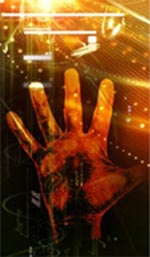Hypnotizers cure male impotence and enuresis
Sometimes it is enough to look at a sparkling Christmas decoration to fall into hypnotic sleep A rabbit is unable to move when hypnotized by boa's eyes. A passerby gives all his salary to a gypsy woman in the street. An illusionist makes a volunteer from the audience fall asleep right on stage. All these are results of one and the same phenomenon called hypnosis.
A rabbit is unable to move when hypnotized by boa's eyes. A passerby gives all his salary to a gypsy woman in the street. An illusionist makes a volunteer from the audience fall asleep right on stage. All these are results of one and the same phenomenon called hypnosis.
It is not necessary to stare into the eyes and to make movements with your hands in order to send a person into trance. Sometimes it is enough to ask him to listen to the rain or to look at the sparkling Christmas decoration. Even lullaby and stroking can be hypnotizing.
If a person is completely relaxed and withdrawn this means he is in hypnotic sleep. Now when the consciousness has lost control over the brain the most interesting moment starts. Hypnotized person can recall the events of the past or to erase completely an unpleasant recollection from his memory. He can do, imagine or feel whatever he is asked to. While in this state a person is vulnerable to verbal suggestion, which is widely used by psychotherapists to cure diseases and by people who have skills of hypnosis to their personal advantage.
The first to discover hypnosis were ministers of religion. Ancient magicians and shamans sent themselves and others present into a state between dreaming and reality with the help of even tom-tom beats and monotonous spells. They used hypnosis to communicate with supernatural powers more effectively and to raise tribe's morale before war or hunting.
The healing properties of hypnosis became known in the ancient world. In the Ancient Greece priests of the temple of medicine god Asclepius even invented a special hypnotizing ritual, after which patients felt better. Hypnosis was used in the Ancient Egypt as well as India. However, Indians practiced it on animals. They charmed snakes and trained tigers.
Hypnosis was popular until about the middle of the 6th century. When the dark medieval times came about inquisitors decided that hypnosis was the devil's fruit. Hypnosis was recalled only in 1530 when a Swiss alchemist and doctor Theophrastus Bombastus von Hohenheim became interested in human psyche. He suggested that some people possessed special powers to influence the others. He discovered the principles of what we know call hypnosis. However, in the 16th century there was no clear idea of how it works. Austrian physician Franz Anton Mesmer united the theory and practice only two centuries later. Although Mesmer was considered a doctor he had little interest in traditional healing methods. He was passionate for stars and magnets. Thanks to his interest in magnets he founded a popular hypnosis theory.
When studying magnet's influence on human organism Mesmer discovered that when stroked with a magnet for a long time the patient became sleepy and after that felt much better. The scientist called this phenomenon magnetism. He was already thinking about the reaction his discovery could provoke. However, he decided to conduct another experiment and putting the magnet aside started stroking the patient with his hand. The result turned out to be the same. He made a conclusion that hands had the power to affect the patient. He changed the name of the phenomenon to animal magnetism.
Mesmer's contemporaries recalled his appearance in Paris, which was really impressive. Crowds of sick Frenchmen gathered in the large square. As Mesmer waved with his hands something really extraordinary happened. Most of the spectators were sent into hypnotic sleep at once. Some went into hysteric, others stiffened.
In 1774 Mesmer set forth his theory about hypnosis (animal magnetism) and its principles at the Paris Academy of Sciences. Conservative physicians did not appreciate mesmerism. In Austria Mesmer was accused of swindle. After that he was forced to move to Francewhere he was welcomed and allowed to open a hospital. However, six years later mesmerism was found useless and animal magnetism non-existent. As a result the hospital was closed.
Meantime, scandalous mesmerism became popular among beau monde. Aristocrats from all European countries went to see the outcast doctor. Many followers of his theory appeared among doctors and magicians.
Mysticism was stopped by the English surgeon James Braid in the middle of the 19th century. After several experiments with his patients he concluded that magnetism was not connected with any magical powers or energies. Sensitive person's brain tired of the same kind of irritants can fall into a sort of sleep. Looking at a sparkling object or magnetizer's hands eyes get tired. Ears get tired because of monotonous sounds. James Braid called the phenomenon hypnosis that means dream in Greek. In 1843 he wrote “Neurohypnology”.
Braid used hypnosis instead of anesthetics during operations. He also managed to make a woman who could not get up for many years walk and recovered completely the eyesight of a blind man.
Braid's discovery led to debates among physicians who split in half. Nancy physician Hippolite Bernheim considered hypnosis to be natural state and a perfect cure for all diseases. Parisian neurologist Jean-Martin Charcot was also interested in hypnosis. However, he thought that patients with hysteria were more susceptible to hypnosis than mentally healthy people. Thus, he considered hypnosis unnatural and harmful for people. At one point even such materialist as Friedrich Engels became interested in hypnosis.
Meantime in Russia progressive scientists were studying the mechanisms of hypnosis. In 1891 physiologist from Kharkov Vasiliy Danilevskiy while giving a talk at the sixth meeting of Society of Russian Physicians suggested that hypnosis of a person is similar to that of an animal: paralysis of will and thought as a result of psychic constraint.
Moscow psychiatrist Ardalion Tokarskiy disagreed with Danilevskiy. He considered hypnosis to be a complex process that could not be explained by mere reflexes. He was the first to organize lectures on hypnology at the Moscow State University.
The founder of Russian psycho neurology Vladimir Bekhterev proved that both psyche and physiology were important in hypnosis. Bekhterev studied the peculiarities of mass suggestibility and worked out principles of collective hypnosis that he used in healing patients in groups.
The most significant impact into understanding hypnosis was made by Ivan Pavlov. He thought that hypnosis was similar to sleep but some of the brain cells remained awake and were disposed to a hypnotizer’s voice.
Soviet school of hypnosis was considered the best in the world from 1920s till 1960s. Hypnotherapists were curing all sorts of diseases from hypertension to impotence. They took part in the radio programs that were transmitted for seamen who suffered from seasickness.
Famous psychotherapist Pavel Bul conducted hypnotic sessions via Leningrad television. The results were unexpected. It turned out that many of spectators were too sensitive to hypnosis. After putting hands in a lock many of the TV patients could not unlink them afterwards. Bul had to go around Leningrad all night to help them.
Another incident happened later with psychotherapist Anatoly Kashpirovsky. In 1989 he was curing involuntary urination by TV-sessions. The scandal broke out later when it turned out that such programs could seriously harm people with unstable psyche.
Nowadays classical hypnosis is not so popular as it used to be. Psychotherapists use so-called mild hypnosis based on the methods of popular neurolinguistic programming. However, it is too early to write the classical hypnosis off. It really works. Approved by Engels.
Subscribe to Pravda.Ru Telegram channel, Facebook, RSS!



